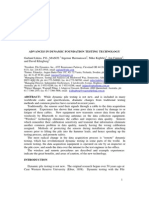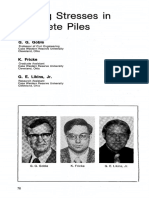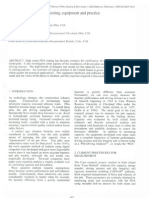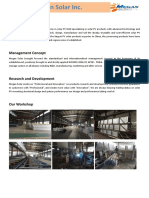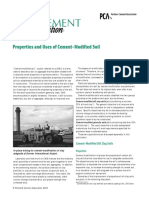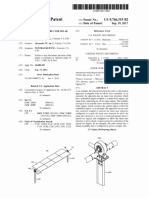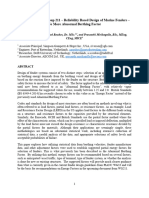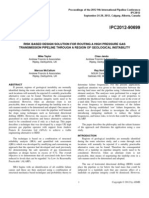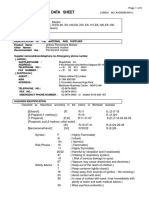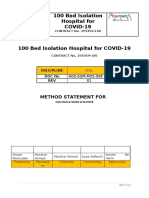Pile Testing
Pile Testing
Uploaded by
Roy LachicaCopyright:
Available Formats
Pile Testing
Pile Testing
Uploaded by
Roy LachicaCopyright
Available Formats
Share this document
Did you find this document useful?
Is this content inappropriate?
Copyright:
Available Formats
Pile Testing
Pile Testing
Uploaded by
Roy LachicaCopyright:
Available Formats
Geo Engineering Test Services cc 353/2 Olifantsfontein Rd, Glen Austin Ah, Midrand, Gauteng, Johannesburg, South Africa
PILE TESTING SELECTION AND ECONOMY OF SAFETY FACTORS Garland Likins, P.E., MASCE ABSTRACT: Historically, while driven piles were designed conservatively by a static analysis, and then almost always installed to a driving formula, the inaccuracy of dynamic formulae for field verification of pile capacity is widely recognized. In some cases the design was verified by a static load test, performed along ASTM D1143 (1994) procedures to a maintained load of two times the design load, which engineers viewed as having the same effect as the pile having a safety factor of two. However, since static tests rarely failed, the actual safety factor was certainly higher. Modern piling practices have seen several improvements. The Federal Highway Administration (FHWA) actively promoted quick static loading procedures to up to three times the design load. Computer analyses with the so-called wave equation(with realistic models for hammer, pile, and soil) have largely replaced dynamic formulae. Over the last 30 years, dynamic pile testing has become routine due to (a) good correlation with static tests to failure, (b) the additional information it provides on hammer performance and driving stresses, and (c) the economy of this testing. Codes, both in public and private sectors, have been developed for both load and resistance factor design (LRFD) and allowable stress design (ASD) to minimize the risk of foundation failures. The selection of global safety factors (or LRFD resistance factors) to satisfy a foundation design with tolerable risk and at an acceptable cost relates to the type and amount of capacity verification performed. Based on a review of several codes, a comparison of traditional methods of dynamic formulae and static analyses with modern methods of analysis and testing is made, demonstrating the economics of the modern methods through the reduction in safety factors.
1 President, Pile Dynamics, Inc., 4535 Renaissance Pkwy, Cleveland, OH 44128, info@pile.com
Geo Engineering Test Services cc 353/2 Olifantsfontein Rd, Glen Austin Ah, Midrand, Gauteng, Johannesburg, South Africa
INTRODUCTION When designing a foundation system, engineers have many choices, including the ultimate load per pile and pile size (type, length, and diameter). The ultimate pile capacity must exceed the applied loads by a sufficient margin or the foundation will have unacceptable movements, or even fail. The required pile capacity also depends on the test method for verification of the pile capacity, and the frequency of testing. Additional geotechnical considerations like consolidation in compressible layers, changes in effective stresses due to changes in the groundwater table, and negative friction are beyond the scope of this discussion and are generally dealt with by the geotechnical engineer of record for the project. Safety factors are assigned to account for uncertainties from unknown loads or loading conditions, site variations, and inaccuracies in load determination methods. Statistical methods can assess risk, and form the basis for the safety factors (differing values depending on the method of load evaluation) proposed by modern codes. Safety factors are either (a) global for allowable stress designs (ASD), or (b) partial for load and resistance factor designs (LRFD). In ASD, the ultimate pile capacity is divided by a global safety factor to find the allowable or working load on the pile, and thus all uncertainty is lumped into this single factor. LRFD designs recognize different loading conditions have different uncertainty and therefore assigns different load factors to these load conditions. For example, the structures dead weight is known while applied live loadings due to wind, earthquake or temporary loads can be highly variable. Thus load factors for dead weights are lower than for live loads. LRFD methods assign different strength factors (often called resistance factors with values less than unity) which relate to the capacity verification procedure reliability. The general expression for LRFD design is: i Q i k R k (1) where i is the load factor for the load Qi of the ith load type (e.g. for the primary load condition of gravity loading, 1 might be 1.4 for the dead load Q1, and 2 might be 1.7 for the live load Q2), and k is the resistance factor for the resistance Rk for the kth limit state (e.g. might be 0.80 for a static load test R on 1% of the piles). In concept, for a given set of load and resistance factors, an equivalent global safety factor can be calculated from the load factor divided by the resistance factor (e.g. in the above examples, the equivalent global safety factor is 1.94 for a 50% dead load situation). Although various codes may use differing load factors and differing resistance factors, the resulting equivalent global safety factor may be comparable for a similar distribution of dead to live load ratio. Because some codes are written in terms of ASD only, this paper will convert LRFD code factors into equivalent global safety factors for specific case of primary gravity loading with 50% dead and 50% live loads to allow direct comparisons. Since load factors are lower for dead loads, and generally the total loads are usually more than 50% dead loads, the resulting converted factors are conservative. The risk of foundation failures makes capacity evaluation necessary. Logically, less testing and less accurate tests increase the risk of a failed foundation, while more testing and more accurate tests reduce risk. The goal of any project design is an acceptably low probability of failure. Piles can potential fail either due to structural failure of the pile itself or geotechnical failure (e.g. soil strength), or because serviceability or deformation limits are exceeded. Generally, driven piles rarely fail structurally because they are manufactured under strict quality control, often using relatively high material strengths. Driven piles are installed to a driving criteria based on blow count and thus when obtained at the expected or typical tip elevation gives indirect assurance of a structurally sound pile. Closed end pipe piles can be visually inspected to assure structural integrity. Drilled or augered piles that are cast-in-place have a higher probability of structural failure due to variability in the construction process, and thus usually have higher associated safety factors, or lower factors on the structural strength conditions. Deflection limits are also usually indirectly satisfied by selection of a sufficient safety factor on strength.
1 President, Pile Dynamics, Inc., 4535 Renaissance Pkwy, Cleveland, OH 44128, info@pile.com
Geo Engineering Test Services cc 353/2 Olifantsfontein Rd, Glen Austin Ah, Midrand, Gauteng, Johannesburg, South Africa
STATIC LOAD TESTING Static testing has traditionally been the standard for evaluating soil strength and thus ultimate pile capacity, although many sites had no testing specified, particularly when the number of piles per project was relatively low as would be the case for a small bridge. For projects of sufficient size, prior to about 1970, piles were tested using a slowly applied load maintained over several days to twice the design load, as specified in ASTM D1143. Generally, only one static test was performed per site and these proof tests rarely failed. The traditional safety factor of 2.0 was thus established because of this loading to only twice the design load, even though actual safety factors were larger since the pile did not fail. Common failure load evaluations were determined by some pile top movement limit (typically 0.75 to 1.5 inches), or a net movement limit (typically 0.25 to 0.75 inches) after load removal. Due to recent emphasis by the FHWA (1997), the quick procedure static test method detailed in ASTM D1143 is becoming more common, the evaluation for failure or ultimate load uses the offset yield line method (generally among the most conservative of failure definitions), and the loads are often carried to failure or to at least three times design load in a test taking only a few hours. When the ultimate failure load can be determined, rather than only a proof load, foundation costs can often be reduced. For large projects, special preconstruction test programs are effective. Fewer piles are required when higher loads are proven, or shorter piles can be used. For smaller projects, the first production piles serve as test piles and some driving criteria adjustment and cost savings are possible if the piles can be shortened. Production piles are driven to the test pile criteria. However, since it is not practical to statically test every pile because of time and cost constraints, such testing is usually limited to a very small sample of piles on any site (typically 1% or less on large projects, or only one per site, if any, for small projects). Static testing accuracy is affected by many factors (Fellenius, 1990). When static testing is performed properly, the measuring accuracy should be within 20% of the true value. The reliability of results is improved if a recently calibrated load cell is specified. However, interpretation of the resulting loadsettlement graph (Fellenius, 1990) can give several different ultimate loads depending on the evaluation method (e.g. Davisson, Chin, Butler-Hoy, double tangent, slope, D/10, etc). Interpretation is also affected by displacement measurement inaccuracies; establishing a true reference that is unaffected by the loading process and by the elements (e.g. temperature and solar influences) is a very difficult assignment. In the extreme case where every pile is tested with a very accurate method (e.g. static load test) with a conservative failure definition, the safety factor can be significantly reduced because the risk is reduced. The offset yield line criteria recommended by the FHWA and the Pile Driving Contractors Association (PDCA) code (PDCA, 2001) is among the most conservative of failure criteria and thus justifies lower safety factors. The PDCA code committee, under the leadership by Dr. G.G. Goble, assigns lower global safety factors for testing more piles, because the uncertainty is reduced. The safety factor varies depending on the amount of testing, ranging from a safety factor of 2.0 for testing only 0.5% of the piles, to a safety factor of 1.65 if 5% of the piles are tested. Piles are selected so site variability is adequately addressed, and adequate hammer performance is periodically verified. A lower safety factor means the pile load can be increased, resulting in fewer piles, or the driving criteria can be relaxed, thus reducing production pile installation time and costs. The extra testing costs are more than compensated by reduced foundation costs.
DYNAMIC PILE TESTING Dynamic testing was pioneered by Dr. G.G. Goble and his colleagues at Case Western Reserve University in Cleveland Ohio and is now a routine pile capacity evaluation method. Dynamic testing requires measuring pile force and velocity during hammer impact (ASTM, 2000) and subjecting this data to a signal matching analysis to determine the soil behavior. Extensive correlations between static and dynamic testing have verified the methods reliability (Likins, 1996), and a discussion of accuracy is included in the Appendix. After correlating the static and dynamic tests, the PDCA code allows substitution of three dynamic tests for one static test in
1 President, Pile Dynamics, Inc., 4535 Renaissance Pkwy, Cleveland, OH 44128, info@pile.com
Geo Engineering Test Services cc 353/2 Olifantsfontein Rd, Glen Austin Ah, Midrand, Gauteng, Johannesburg, South Africa
determining the quantity of further testing. Thus, with at least one successful correlation, the PDCA suggests that 5% static testing can be translated into testing 15% of the piles dynamically, for the same suggested global safety factor of 1.65. It is probably implicitly assumed that the large number of tests allows site variability to be properly assessed and hammer performance to be evaluated periodically throughout the project duration. In many cases dynamic pile testing has completely replaced static testing. In this case no site specific correlation is established and there is a higher risk, since the correlation depends upon past experience. This extra risk requires an increased safety factor compared with static testing methods. In this case, the global safety factor in the PDCA code can vary from 2.1 with only 2% of the piles tested dynamically down to 1.9 when at least 10% of the piles are tested dynamically. To obtain a reliable ultimate capacity from dynamic pile testing, some very basic guidelines must be followed. The hammer input must produce a minimum set per blow so that the soil is loaded sufficiently to mobilize the full soil strength. In cases where the set per blow is very small (e.g. large blow count), the dynamic pile test will activate only a portion of the full soil strength and thus will under predict the true ultimate capacity (this is analogous to a static proof test), so the result is conservative. Finally, the pile capacity of driven piles often changes with time after installation (usually increases due to setup, although in some cases reduction due to relaxation are found). To measure these time dependent capacity effects, the driven pile should be tested by restrike after an appropriate waiting time. Restrike tests are recommended standard practice for capacity valuation by dynamic pile testing. Dynamic testing provides other benefits for driven piles. Dynamic pile testing provides valuable additional information on driving stresses, which if too large can result in pile damage. Pile integrity can be evaluated dynamically for both location and extent of damage, if any. Proper hammer performance is extremely important for driven piles because engineers rely on the blow count (or set per blow) as a driving criteria for pile acceptance, thus implicitly assuming that the hammer is performing properly. By periodic monitoring throughout larger projects we can assure that the hammer is performing properly and consistently during the entire project so that the same initial driving criteria can be used for all piles with confidence. Periodic testing can check site variability and investigate the cause of piles that are too short or too long or that have unusual blow count records to determine if the cause is the hammer or the pile or the soil. These guidelines for checking site variability and periodic hammer verifications are mentioned in the PDCA code. Dynamic pile testing is often performed on drilled piles and augercast piles, where the capacity is also time sensitive; the testing must be carried out after the concrete or grout has attained adequate strength, so a sufficient wait to allow the soil strength to recover from the installation process is naturally attained. The generally used procedure is to use a drop weight for the impact so that the drop height and number of blows applied is controlled. A relatively thin plywood cushion (typically 50 to 100mm) is placed at the pile top to distribute the loads. Usually an initial small impact is applied to check the instrumentation and alignment. Blows with increasing drop height are then applied until either the stresses reach the strength limits of the pile, or until the set per blow exceeds about 3 mm which activates the full capacity, or until the result indicates a capacity sufficiently in excess of the requirements for the project, whichever comes first. The recommended drop weight is at least 1% of the required ultimate capacity to be proved for shafts installed in clay soils or into rock sockets (Hussein, 1996). For piles with larger expected end bearing contributions, the recommended percentage increases to at least 2% of the load to be tested. WAVE EQUATION ANALYSIS This computer simulation of the pile driving process has a numerical model which is constructed for the hammer, for the pile, and for the soil. Numerous assumptions are made such as hammer performance and soil response behavior. Assumed ultimate capacities are entered, a one dimensional wave propagation analysis is made, and the resulting blow counts are predicted. A series of assumed resistances and associated predicted blow counts produce a bearing graph to establish a suggested driving criteria. However, because of the increased uncertainty associated with the assumptions, the risk is increased and thus the safety factors in the AASHTO (1992) and PDCA codes are suggested as 2.75 and 2.5, respectively.
1 President, Pile Dynamics, Inc., 4535 Renaissance Pkwy, Cleveland, OH 44128, info@pile.com
Geo Engineering Test Services cc 353/2 Olifantsfontein Rd, Glen Austin Ah, Midrand, Gauteng, Johannesburg, South Africa
DYNAMIC FORMULA These energy formula were developed over 100 years ago to estimate pile capacity by simple energy considerations. Some engineers still use them today to make a preliminary selection of hammer size. However, these methods are very simplistic. Numerous studies have concluded that their prediction accuracy is poor (Olsen, 1967), and to minimize risk, large safety factors are necessary. The standard ENR formula for example has a theoretical safety factor of 6. Recent studies have shown that the Gates formula is statistically the best for prediction (Long, 2002). Thus the Gates formula is the only formula currently recognized by the PDCA, American Association of State Highway and Transportation Officials (AASHTO), and the FHWA (although FHWA strongly recommends that dynamic formula be replaced by wave equation analysis). Since the coefficient of variation is relatively high, and the risk increased, the PDCA recommended safety factor for the Gates formula is 3.5.
STATIC ANALYSIS In the design process, geotechnical engineers estimate pile capacity from soil strength estimates obtained from site soil investigations to obtain a preliminary design length for bidding purposes. Numerous correlations and empirical correction factors for soil strength were developed for SPT, CPT, or other soil sampling tools. However, there is generally considerable scatter in strength prediction results and local experience does not transfer to differing conditions or differing sampling methods. Numerous prediction events have demonstrated that such predictions are generally highly inaccurate, particularly in sandy soil conditions where strength is determined by SPT N-values (Long, 2002). Thus, because of large inherent risk due to poor prediction accuracy, the PDCA code requires a safety factor of 3.5 for piles installed using only a static analysis. In general practice, driven piles are almost never installed to a depth from a static analysis alone, but the final installation is governed by blow count determined by dynamic methods or confirmed by static test.
COMPARISON OF CODES The various codes, summarized in Table 1, provide an interesting focus for comparison. The PDCA code (PDCA 2001), referenced previously, is the official recommendation of the piling contractors in the USA. The PDCA codes ASD factors originated from the AASHTO Standard ASD code (1992). The percentage of piles tested influences the global safety factor in the PDCA code as already noted. AASHTO represents the 50 state highway departments and thus covers bridge design in the USA. AASHTO is moving toward LRFD, but the result is still under development. Because of similarities of origin, factors for static analyses and dynamic formula are identical to the PDCA code. AASHTO recognizes that wave equation analysis is more reliable than dynamic formula so the safety factor is set at 2.75. The AASHTO code for dynamic testing does not specifically mention signal matching and thus may partially account for the relatively high factor 2.25 for dynamic testing. Static testing alone has the traditional standard factor of 2.0. Testing both statically and dynamically results in a lower safety factor of 1.9. Generally the AASHTO code does not address the amount of testing to be performed. The International Building Code (IBC, 2000) is an effort by the three USA regional building codes to form a single national code covering structures in the USA. The foundation section comes originally from the Southern Building Code (Cobb, 2002) with its base from the 1940's and an update in 1982 to cover new technology items missing from the original code (e.g. prestressed piles), but nothing new relating to safety factors. The IBC does provide for dynamic pile testing (as per ASTM D4945) as a new inclusion of this new code. This SBC code is obviously the oldest among the codes discussed in this paper, and generally reflects older practice requirements. For piles with design loads under 40 tons, capacity is determined by an approved driving formula,
1 President, Pile Dynamics, Inc., 4535 Renaissance Pkwy, Cleveland, OH 44128, info@pile.com
Geo Engineering Test Services cc 353/2 Olifantsfontein Rd, Glen Austin Ah, Midrand, Gauteng, Johannesburg, South Africa
Table 1. Equivalent Global Safety Factors for Various Deep Foundations Codes Australia AASHTO EC7 (2) (3) PDCA (4) (6) 2001 (d) 1995 (c) 2001 1992 50% DL 50% DL 2.12 to 3.44 3.5 3.5 2.5 to 3.06 3.5 3.5 2.5 to 3.06 2.5 2.75 2.25 2.23 (#=2) 2.12 (<3%) 2.1 (2%) 1.72 1.95 (#>20) (>15%) 1.9 (10%) 2 2.29 (1) 1.93 (<1%) 2 (<0.5%) 1.64 (>5) 1.53 (>3%) 1.65 (>5%) (g) ASCE Driven Piles (4) 1996 (f) 16 to 40 NA 2.0 - 2.4 1.8 to 2.2 1.6 to 2.0 (g) (e) 1.9
Code (1) Year Design load - Tons Static Analysis Dynamic formula Wave Equation Dynamic Test (a) Low (# tests) High (# tests) Static test Low (# tests) High (# tests) Static & Dynamic (a,b)
2000
6 NA NA 2 (b)
(g)
Code (1) Year Design load - Tons Static analysis Dynamic Formula Wave Equation Dynamic test (a) Low (# tests) High (# tests) Static test Low (# tests) High (# tests) Static & Dynamic (a,b) Notes: a B C D E F G NA NR
ASCE Driven Piles (5) 1996 (f) 40 to 100 NA NR 1.9 to 2.3 1.7 to 2.0
ASCE Driven Piles (6) 1996 (f) >100 NA NR NR 2.0 to 2.4
1.5 to 1.8
1.6 to 1.9
1.8 to 2.2
(g)
(g)
(g)
Dynamic testing requires signal matching requires atleast one correlating static test dynamic formula for sands only - not clays draft code 3 dynamic tests can be substituted for 1 static test depends on pile type, site variability, load conditions, etc. no specific guidance not applicable not recommended
1 President, Pile Dynamics, Inc., 4535 Renaissance Pkwy, Cleveland, OH 44128, info@pile.com
Geo Engineering Test Services cc 353/2 Olifantsfontein Rd, Glen Austin Ah, Midrand, Gauteng, Johannesburg, South Africa
or by static analysis, with no load testing required. The static analysis uses either a soils investigation or a safety factor of 6 referenced to a chart of conservative soil strengths. For loads of 40 tons or higher, wave equation analysis is specified to estimate the driving criteria, and the load is to be verified by either static or dynamic testing (dynamic testing in ASTM D4945 indirectly implies at least one correlating static test). In contrast to IBC 2000, the Australian Code AS2159-1995 is perhaps one of the most progressive in the world. AS2159 is an LRFD code and the global factors shown in Table 1 for comparison are computed from an equal weighting of live and dead loads (having 1.5 and 1.25 primary load factors respectively), resulting in a generally conservative presentation of global factors. The range of safety factors in the code is given with some guidance by the code. The dynamic formula factors are to be applied to sandy soils only; dynamic formulae are prohibited for clay soils. Factors for static analysis are based on the soil exploration method (e.g. SPT or CPT; CPT methods are given higher confidence and thus lower safety factors). The dynamic testing factors require signal matching. Lower safety factors for dynamic testing require at least 15% of the piles to be dynamically tested (and also comprehensive site investigations and careful construction control), while higher factors are used when less than 3% of the piles are dynamically tested. The lowest static testing safety factors come from statically testing more than 3% of the piles, while higher factors apply when less than 1% of the piles are statically tested. The Eurocode 7 (draft 2001) is also a progressive LRFD code and the global factors shown here for comparison are conservatively computed from an equal weighting of live and dead loads (having 1.5 and 1.35 primary load factors respectively). In contrast to the PDCA and Australia codes which rely on the percentage of piles tested, the global safety factor for Eurocode is dependent upon the number of tests performed. In the opinion of this author, it is preferable to base the number of tests on a percentage of total piles on site when the project requires a substantial number of piles so that site variability and consistency of performance are adequately investigated. Global safety factors for tension loadings are about 10% higher. The factors presented in Table 1 are applied to the mean result for the tests. Eurocode 7 also specifies separate minimum factors for comparison with any individual test result. These minimum factors are generally slightly less than the mean factors which allow an individual pile to have a global safety factor less than these mean values. However, if one test result falls below the minimum, that pile must be driven further even if the mean of all tests is acceptable. The ASCE 20-96 (ASCE, 1997) is the Standard Guidelines for the Design and Installation of Pile Foundations. This code is quite different from others in that the safety factor is defined by three parts (capacity determination method, design axial load levels, and structural pile type). The capacity determination method is the only common criteria with other codes. The criteria related to design load has come under sharp criticism (Cobb, 2002). Because of more structural uncertainty, this code requires significantly higher safety factors for non-driven piles. Determination of capacity solely on static analysis is not recommended for piles with design loads over 40 tons. Except for lightly loaded piles, dynamic formula are not recommended and no factors are even suggested (factors for lightly loaded piles are unrealistically small for the associated risk). The factors for dynamic and static testing are generally similar to PDCA values for lower pile loads, but the factors are higher than the PDCA values for piles with design loads of 40 tons or more. The ASCE code is currently in a revision process and safety factors are likely to be reduced for the higher load cases. The current 2004 draft provisions remove the criticized dependence on the design load but still relate the safety factor to the pile type which reflects the uncertainty associated with the pile quality and installation process. Closed end steel pipe piles have the lowest safety factors since they can be fully inspected following installation. Factors for other driven piles are slightly higher. Factors for augercast piles and temporarily cased drilled shafts have factors which are still higher, and the highest factors are associated with drilled shafts without temporary casing (and presumably installed with wet methods).
1 President, Pile Dynamics, Inc., 4535 Renaissance Pkwy, Cleveland, OH 44128, info@pile.com
Geo Engineering Test Services cc 353/2 Olifantsfontein Rd, Glen Austin Ah, Midrand, Gauteng, Johannesburg, South Africa
EXAMPLE Consider a project requiring 20 columns, each with an ultimate column load of 2000 tons. Further, the ultimate load per pile (determined by any method) is assumed to be 200 tons. Using the global safety factors contained in the PDCA code for a static analysis with verification by dynamic formula, the design load for each pile would be 57 tons, requiring 35 piles per column and a total of 700 piles for the project. If the piles are each 60 ft in length and the cost per foot is assumed to be $30 per foot, the total pile cost is $1,260,000. By simply running a wave equation analysis, the global factor drops to 2.5 and the design load per pile can be increased to 80 tons. The project then requires only 500 piles, and the total cost of the foundation piles drops to $901,000 (a savings of $360,000 in return for a $1,000 engineering cost). For this same example, the cost of a day of dynamic testing is assumed to be $3,000 and that 10 piles are tested per day in restrike (Capacity is usually confirmed by restrike. Cost includes signal matching on about one-third of all piles tested which is typical practice and required by the PDCA code). It is further assumed that the first static test to 200 tons on the project costs $15,000 (which includes the initial mobilization costs), and subsequent tests are then $10,000. Table 2 summarizes the costs of the pile installation and test costs for different combinations of dynamic and static test methods to verify the pile capacity. Depending on the percentage of piles tested and the type of testing, the number of piles required per column drops to between 21 and 17 (actually 16.5 but an integer number of piles per column is required), and the design loads increase to 95 to 121 tons. The total cost, including testing, then ranges from $759,000 with relatively minimal dynamic testing, to $745,000 with minimal static testing, down to $642,000 with an extensive mix of dynamic and static testing. Thus with even with minimal dynamic or static testing, the total foundation costs are reduced by over $450,000. With sufficient testing the total foundation savings exceed $600,000. Thus, the investment in testing provides cost savings which benefit the project costs and more than justify the testing. While the total costs would vary when other codes are used, the general conclusion that testing substantially reduces the total costs would remain the same.
Table 2. Project Cost Analysis Capacity variation Method (1) dynamic formula wave equation dynamic test (2%) dynamic test (10%) static test (0.5%) static test (2%) static test (1) + dynamic (6%) static test (1) + dynamic (15%) PDCA Safety Factor (2) 2.50 2.50 2.10 1.90 2.00 1.80 1.80 1.80 Design Load per Pile (T) (3) 57 tons 80 95 105 100 111 111 121 Total Piles per project (4) 700 500 420 380 400 360 360 340 Pile Cost $ (5) 1 260 000.00 900 000.00 756 000.00 684 000.00 720 000.00 648 000.00 648 000.00 612 000.00 Testing Cost $ (6) Total Cost $ (7)
100.00 1 000.00 3 000.00 11 400.00 25 000.00 75 000.00 21 480.00 30 300.00
1 260 100.00 901 000.00 759 000.00 695 400.00 745 000.00 723 000.00 669 480.00 642 300.00
1 President, Pile Dynamics, Inc., 4535 Renaissance Pkwy, Cleveland, OH 44128, info@pile.com
Geo Engineering Test Services cc 353/2 Olifantsfontein Rd, Glen Austin Ah, Midrand, Gauteng, Johannesburg, South Africa
This example clearly demonstrates the potential savings available. It does assume that the pile length remains unchanged and thus that the soil conditions are favourable to this assumption (e.g. a clearly defined bearing layer exists). Cost savings are still likely to be substantial even if the piles must be driven a little deeper. There are other means for cost savings. There is a trend to increased design loads on the same pile section. As a result of increased testing, the design loads for the same concrete pile sections in Sweden have doubled since the late 1970s (Gravare 2000). Recent efforts in the USA have resulted in doubling of design stresses on several projects (Miner 2001, and Frazier 2002). It should be noted in the former case, that savings were estimated at $1,500,000, and in the later case that the savings were only about 35% of the total cost because the piles were driven a little deeper to gain the extra capacity and the number of piles can be reduced by half only when there is an even number of piles in every column. Design stress increases should only be permitted when driveability by wave equation is confirmed, and when the soil conditions are favorable, and when the ultimate loads verified by testing. Other savings have been noted by reducing the pile lengths for the same design load from the original project design (based on static analysis). Testing at various times both at end of driving and during restrike after a waiting period can quantify setup, a soil strength gain with time after driving, which can be effectively used in the pile design (Komurka 2002). By taking advantage of strength gains (only possible with sufficient testing) smaller hammers, shorter piles, higher loads can be used, and considerable savings can result. Cost savings can be quantified by looking at support costs which are defined as cost per unit load (Komurka 2003), and the foundation solution (pile type and pile length) determined for the lowest possible foundation cost. In another recent case, for example, the savings resulted in a substantially reduced pile length (over 35,000 ft saved for the project) and a cost savings of over $1,000,000 for the project (Lee 2003). This length savings further resulted in eliminating pile splices for most piles, and the reduced time required for installing the shorter lengths and elimination of splices resulted in keeping the installation scheduling on track.
CONCLUSIONS Keeping the risk of foundation failure below an acceptable level is the goal for any foundation. To accomplish this, safety factors are applied to the ultimate pile capacity to calculate an acceptable design or working load for the piles. The risk of failure can be reduced by testing more piles, or using evaluation methods that are more accurate. A reduced risk of failure justifies lower safety factors. As a common practice, static analysis methods are generally only used to estimate pile lengths in the design process. Rarely are pile installations governed by this method, so whether a code has a factor or not for static analysis is almost a non-issue. Dynamic formulae are also decreasing in usage. They remain mainly a tool for preliminary hammer selection. In most cases, actual use of dynamic formula to govern pile installation is perhaps limited to projects with few piles and light design loads. From a practical view, a wave equation analysis is almost as fast and simple as a dynamic formula, and result in cost savings from a lower safety factor specified in the codes. Generally some other more precise method (wave equation, dynamic testing, or static testing) is also specified on most projects, particularly projects with design loads above 40 tons, so the lower safety factor and improved reliability of the more accurate methods would then govern the project anyway. The safety factors recommended by several newer codes generally give a range of safety factors depending on the type and amount of testing performed on site, and result in factors less than the traditional factor of 2.0. These more modern testing methods, combined with a higher frequency of testing and the resulting lower safety factors, can substantially reduce the total foundation costs. REFERENCES AASHTO. (1992). Standard Specifications for Highway Bridges, Fifteenth Edition. American Association of State Highway and Transportation Officials, Washington D.C. ASCE. (1997). Standard Guidelines for the Design and Installation of Pile
1 President, Pile Dynamics, Inc., 4535 Renaissance Pkwy, Cleveland, OH 44128, info@pile.com
Geo Engineering Test Services cc 353/2 Olifantsfontein Rd, Glen Austin Ah, Midrand, Gauteng, Johannesburg, South Africa
Foundations 20-96. ASCE, ISBN 0-7844-0219-1, Reston VA. 250 ASTM D1143. (1994). Standard Test Method for Piles Under Static Axial Compression Load. Annual Book of ASTM Standards, Vol. 4.08, ASTM International, West Conshohocken, PA. ASTM D4945. (2000). Standard Test Method for High-Strain Dynamic Testing of Piles. Annual Book of ASTM Standards, Vol. 4.08, ASTM International, West Conshohocken, PA. Cobb, L., A. Gallet and C. Drew. (2002(. Proposed Overhaul of Deep Foundation Provisions of the International Building Code. Proc. of International Deep Foundations Congress 2002, Geotechnical Special Publication No. 116, ASCE. pp 1064-1072. European Committee for Standardization. (2001). Eurocode 7: Geotechnical Design Part 1 General Rules. Central Secretariat, Brussels, Belgium. Fellenius, B. (1990). Guidelines for the Interpretation and Analysis of the Static Loading Test, Deep Foundations Institute, Hawthorne, NJ. FHWA. (1997). Design and Construction of Driven Pile Foundations. FHWA HI 97-013, National Highway Institute, U.S Department of Transportation, Federal Highway Administration, Washington D.C. Frazier, J., G. Likins, F. Rausche, and G. Goble. (2002). "Improved Pile Economics: High Design Stresses and Remote Pile Testing." 27th Annual Conference on Deep Foundations, San Diego, CA, Deep Foundations Institute, Hawthorne, NJ. Goble, G.G. (1999). NCHRP Synthesis 276: Geotechnical Related Development and Implementation of Load and Resistance Factor Design (LRFD) Methods. ISBN 0-309-06854-1, Transportation Research Board, National Academy Press, Washington D.C. Gravare, C.J. (2000) Innovations in Scandinavia. Proceedings of the 25th annual meeting and 8th International Conference, N.Y., Deep Foundations Institute, Hawthorne NJ. Hussein, M., G. Likins, and F. Rausche. (1996). "Selection of a Hammer for HighStrain Dynamic Testing of Cast-in-Place Shafts." Proceedings of the 5th International Conference on the Application of Stresswave Theory to Piles, Orlando, FL. International Code Council. (2000). International Building Code. Komurka, V. and S. Piefer. (2003). "Determination of Support Cost Distribution for the Design of Driven Piles Exhibiting Set-Up." PDCA Roundtable, Atlanta, GA. Komurka, V. (2002). "Incorporating Set-Up into the Design and Installation of Driven Piles." Third Annual Design & Installation of Cost-Efficient Driven Piles Symposium, New Orleans, LA, PDCA, Boulder CO. Lee, M. and W. Cody. (2003). Design of High Capacity Piles including Setup and Soil Tightening. Proceedings of the 4th Annual Design and Installation of CostEfficient Driven Piles Symposium, Chicago, IL, PDCA, Boulder CO. Likins, G., F. Rausche, G. Thendean, and M. Svinkin. (1996). "CAPWAP Correlation Studies." Proceedings of the 5th International Conference on the Application of Stresswave Theory to Piles, Orlando, FL. Long, J.H. (2002). Resistance Factors for Driven Piling Developed from Load-Test Databases. Proc. of International Deep Foundations Congress 2002,
1 President, Pile Dynamics, Inc., 4535 Renaissance Pkwy, Cleveland, OH 44128, info@pile.com
Geo Engineering Test Services cc 353/2 Olifantsfontein Rd, Glen Austin Ah, Midrand, Gauteng, Johannesburg, South Africa
Geotechnical Special Publication No. 116, ASCE. pp 944-960. 251 Miner, R., and T. Gurtowski. (2001). Driven Piles for Safeco Field, Proceedings of the Conference on Design and Installation of Cost-Efficient Driven Piles. PDCA, Boulder CO. Olsen, R.E. and R.S. Flaate. (1967). Pile Driving Formulas for Friction Piles in Sand, J. of Soil Mechanics and Foundation Engineering, ASCE, Vol 93, No. SM6, November, pp 270-296. Paikowsky, S. and Stenersen, K., 2000. The performance of dynamic methods, their controlling parameters and deep foundation specifications, Proc. of the 6th Intl
Conf. on Application of Stresswave Theory to Piles. Balkema, Sao Paulo Brazil.
Pile Driving Contractors Association (PDCA). (2001). Recommended Design Specifications for Driven Bearing Piles. PDCA, Boulder, CO. Standards Australia. (1995). Australian Standard, Piling Design and Installation. ISBN 0-7262-9884-0, Homebush NSW, Australia. APPENDIX The accuracy of dynamic testing capacity predictions has been the subject of many past studies. In order to reliably use the dynamic testing results, many have compared the dynamic testing results with static load tests on the same piles. Of course both should be run to failure (e.g. have a sufficiently large permanent set), and ideally both would be performed with similar wait times after installation so that known strength changes with time would be minimized. Table A1 statistically compares the dynamic testing results with signal matching (e.g. CAPWAP) against static load tests for three major studies. In the original study by Goble (1980) containing 77 driven piles, the average CAPWAP result was 1.01 times the static load test, and a 0.168 coefficient of variation (COV) which measures the dispersion of results or reliability. The 1996 study (Likins, 1996) for 83 other driven piles had an average ratio of 0.931 with a similar COV reliability (0.166) for the normal best match analysis. The radiation damping model gave an average closer to unity for the 1996 data and a very low COV (but should be restricted to displacement piles with moderate to high blow counts). The fully automatic computer optimization (with no user input) gave very good results for the 1996 data. A review of all six previous Stresswave (SW) Conferences results in a database of such information. It was found that the average of 143 additional correlations was a ratio of 0.993 with a COV of 0.165. The COV for driven piles was lower, probably due to better known pile properties and more test cases, than for drilled shafts and CFA piles. It is also interesting and understandable that better correlations (lower COV values) are obtained when the time ratio of dynamic testing (during restrike) after installation is more similar to the time of static testing (e.g. generally requires dynamic testing at least 5 days after installation). While the 1980 and 1996 results always used the Davisson criteria to evaluate the static test, the authors failure evaluation procedure was often unknown in the Stresswave study. In some cases, the static load test curve and the simulated static test from CAPWAP were available. Comparison of the CAPWAP result and the static result, each at a deflection of 20 mm, results in an average ratio of 0.968 with a COV of only 0.101. From this analysis it would appear CAPWAP does an excellent job of predicting the load versus displacement behavior at lower loads (e.g. working loads) in the elastic zone. Combining all studies, the average ratio for 303 piles was 0.98 with a COV of 0.169. The comparison of this correlation is shown in Figures A1 and A2. It should be generally noted that correlation of one definition of failure versus another on the same piles results in similar statistical confidence (Paikowsky 2000), and thus it could be concluded that CAPWAP is statistically similar to other evaluation procedures. The Davisson method is among the most conservative of all evaluation procedures, and thus there is often additional reserve strength present. Thus evaluations with Davisson and CAPWAP are generally considered conservative. Lower safety factors would be appropriate for conservatively evaluated static tests.
1 President, Pile Dynamics, Inc., 4535 Renaissance Pkwy, Cleveland, OH 44128, info@pile.com
Geo Engineering Test Services cc 353/2 Olifantsfontein Rd, Glen Austin Ah, Midrand, Gauteng, Johannesburg, South Africa
1 President, Pile Dynamics, Inc., 4535 Renaissance Pkwy, Cleveland, OH 44128, info@pile.com
You might also like
- NVQ 3 AnswersDocument47 pagesNVQ 3 Answersjames.rawcliffe123100% (1)
- Kids Clothing Safety Manual 2022Document85 pagesKids Clothing Safety Manual 2022mdfazle165No ratings yet
- CapwapDocument2 pagesCapwapjilofeNo ratings yet
- SOP of Bearing ChangeDocument9 pagesSOP of Bearing ChangeDwitikrushna Rout100% (4)
- 3a - Sample Permit To Work TemplateDocument2 pages3a - Sample Permit To Work TemplateRavikant PandeyNo ratings yet
- Design of Piles Under Cyclic Loading: SOLCYP RecommendationsFrom EverandDesign of Piles Under Cyclic Loading: SOLCYP RecommendationsAlain PuechNo ratings yet
- Advances Dynamic Pile Testing Technology - Independent Geoscience Pty LTDDocument8 pagesAdvances Dynamic Pile Testing Technology - Independent Geoscience Pty LTDindependentgeoscienceNo ratings yet
- Pile Design and Construction Practice - M.J.tomlinsonDocument129 pagesPile Design and Construction Practice - M.J.tomlinsonchongpt0% (1)
- Astm D5334-08 Método para Determinar Conductividad Térmica en Suelos y RocasDocument9 pagesAstm D5334-08 Método para Determinar Conductividad Térmica en Suelos y RocasterragualaboratorioNo ratings yet
- Driving Stresses in Concrete PilesDocument19 pagesDriving Stresses in Concrete PilesPaolo RuaroNo ratings yet
- A New Method For Single Pile Settlement Prediction and AnalysisDocument5 pagesA New Method For Single Pile Settlement Prediction and AnalysisCesar Felipe Jimenez SantiagoNo ratings yet
- CIvil SpecificationDocument45 pagesCIvil Specificationanoop13No ratings yet
- Compaction GroutingDocument10 pagesCompaction GroutingRainndrop FonnyryNo ratings yet
- 15h30 Garland Likins 23 06 Plenaria 4x3Document71 pages15h30 Garland Likins 23 06 Plenaria 4x3Paula NejaimNo ratings yet
- Garland Dynamic TestingDocument27 pagesGarland Dynamic TestingmarcvenzNo ratings yet
- Modeling of Vibratory Pile DrivingDocument12 pagesModeling of Vibratory Pile DrivingAlberto AguilarNo ratings yet
- CAPWAP Description WebinarDocument41 pagesCAPWAP Description WebinarCristian Sandoval100% (1)
- Taylors Slope Stability Charts Revisited - 2011Document5 pagesTaylors Slope Stability Charts Revisited - 2011S MNo ratings yet
- PDA TestDocument7 pagesPDA TestChing EtNo ratings yet
- Methodology For Pile Load Test (Dynamic) 1Document5 pagesMethodology For Pile Load Test (Dynamic) 1rohit singhNo ratings yet
- Pile Dynamic Test PDFDocument69 pagesPile Dynamic Test PDFYosafat JuwonoNo ratings yet
- Eng-Tips Example PDFDocument8 pagesEng-Tips Example PDFNarayanan JayachandranNo ratings yet
- Pile Driving ReportDocument12 pagesPile Driving ReportJun CrisostomoNo ratings yet
- Trina Solar Annual ReportDocument29 pagesTrina Solar Annual ReportenesteeNo ratings yet
- p Y曲線應用砂土層離岸風機群樁基礎之行為分析Document140 pagesp Y曲線應用砂土層離岸風機群樁基礎之行為分析張致愷No ratings yet
- Session 3 - WIND TURBINE FOUNDATIONS Structural Design Principles and Practices - FULLDocument68 pagesSession 3 - WIND TURBINE FOUNDATIONS Structural Design Principles and Practices - FULLdebbyNo ratings yet
- Ground Screw Solutionfor Rapid Foundation Constructionof Trattic Control Devicesand Other StructuresDocument6 pagesGround Screw Solutionfor Rapid Foundation Constructionof Trattic Control Devicesand Other Structuresnoppadol.chNo ratings yet
- Megan Solar Inc.: Company ProfileDocument24 pagesMegan Solar Inc.: Company ProfileCarlo CecchettiNo ratings yet
- Drilled Shaft Lateral Load Test ClayDocument110 pagesDrilled Shaft Lateral Load Test ClaychrtromNo ratings yet
- Design of Wind Turbine Foundation Slabs - Pekka Maunu - 2008Document91 pagesDesign of Wind Turbine Foundation Slabs - Pekka Maunu - 2008Bza ZaBugNo ratings yet
- An Application of Spherical Cavity Expansion Theory in Soft Rock Pile-Base ResistanceDocument11 pagesAn Application of Spherical Cavity Expansion Theory in Soft Rock Pile-Base ResistanceHuang BenNo ratings yet
- CE325 - 12 Terzaghis BC EquationsDocument17 pagesCE325 - 12 Terzaghis BC EquationsRobert PrinceNo ratings yet
- Pile Driving EquipmentsDocument23 pagesPile Driving EquipmentsAbhishek BhushanNo ratings yet
- Nasa - cr-1457 Manual For Structural Stability Analysis of Sandwitch Plates and ShellsDocument404 pagesNasa - cr-1457 Manual For Structural Stability Analysis of Sandwitch Plates and Shellsmattrix007No ratings yet
- PCA Soil - Properties and Uses of Cement-Modified Soil PDFDocument12 pagesPCA Soil - Properties and Uses of Cement-Modified Soil PDFpabulumzeng100% (1)
- Interpretation of Centrifuge CPT Data in Normally Consolidated Silica and Carbonate SandsDocument10 pagesInterpretation of Centrifuge CPT Data in Normally Consolidated Silica and Carbonate SandsNatasa KaticNo ratings yet
- TENSAR Cement StabilizationDocument72 pagesTENSAR Cement StabilizationHenrry L. Gonzales Fernández100% (1)
- Us9766319 PDFDocument74 pagesUs9766319 PDFloloNo ratings yet
- Lecture 10-BC-Layered Cohesionless Soil and Linearly Varying StrengthDocument11 pagesLecture 10-BC-Layered Cohesionless Soil and Linearly Varying StrengthBrajesh Ranjan AcharyaNo ratings yet
- 구조물 기초설계기준 (2014)Document107 pages구조물 기초설계기준 (2014)MyunSu GooNo ratings yet
- Solar Power PlantDocument32 pagesSolar Power PlantShailendraNo ratings yet
- Circular FoundationDocument22 pagesCircular FoundationnittaNo ratings yet
- K. Kinra, King-Wilkinson, Inc. and P. W. Marshall, Shell Oil CoDocument18 pagesK. Kinra, King-Wilkinson, Inc. and P. W. Marshall, Shell Oil Cokalyan rangadham100% (1)
- Sample L Pile OutputDocument10 pagesSample L Pile OutputManikumar Chebolu100% (1)
- Supplement To Austroads Guide To Bridge Technology Part 8, Chapter 5: Bridge Scour (2018)Document69 pagesSupplement To Austroads Guide To Bridge Technology Part 8, Chapter 5: Bridge Scour (2018)Vishnu S DasNo ratings yet
- A Correlation Between Dynamic and Static Pile Load Test ResultsDocument8 pagesA Correlation Between Dynamic and Static Pile Load Test ResultsErkan ŞamhalNo ratings yet
- Driven Plate Anchors For Mooring Caissons PDFDocument8 pagesDriven Plate Anchors For Mooring Caissons PDFthadikkaranNo ratings yet
- Wajac StandardDocument22 pagesWajac StandardajayNo ratings yet
- KDS 171000-내진설계 일반Document26 pagesKDS 171000-내진설계 일반박현도No ratings yet
- Manual For Design and Construction Monitoring of Soil Nail WallsDocument3 pagesManual For Design and Construction Monitoring of Soil Nail Wallsmauricio buenoNo ratings yet
- Driven Pile Design Methods in Weak Rock: September 2017Document7 pagesDriven Pile Design Methods in Weak Rock: September 2017Anonymous I8nZsDqlmhNo ratings yet
- Piles IntroductionDocument39 pagesPiles IntroductionKhushboo PriyaNo ratings yet
- SUT-OSIG-12-50Modification of The API P-Y Formulation of Initial Stiffness of SandDocument8 pagesSUT-OSIG-12-50Modification of The API P-Y Formulation of Initial Stiffness of Sandcastille1956100% (1)
- Only / Underline Format: Chapter C31 Wind Tunnel ProcedureDocument11 pagesOnly / Underline Format: Chapter C31 Wind Tunnel ProceduresharethefilesNo ratings yet
- Comparison of Foundation Design Specifications For Vibratory MachinesDocument10 pagesComparison of Foundation Design Specifications For Vibratory MachinesJosé Antonio Alarcón LeónNo ratings yet
- GameChange Solar Genius - Tracker 1P Technical - Datasheet 7 13 2022Document2 pagesGameChange Solar Genius - Tracker 1P Technical - Datasheet 7 13 2022ThorstenNo ratings yet
- Example 1: Generation of A Bearing Graph For An Open End Diesel HammerDocument5 pagesExample 1: Generation of A Bearing Graph For An Open End Diesel HammerbozarromegustaNo ratings yet
- Catalog Suruburi KrinnerDocument49 pagesCatalog Suruburi KrinnergabisolomonNo ratings yet
- Wind Tunnel Methods2Document21 pagesWind Tunnel Methods2mdkml2100% (1)
- Case Method and The Pda PDFDocument73 pagesCase Method and The Pda PDFStephanie HaynesNo ratings yet
- PORTS2022 NomoreabnormalberhtingfactorDocument10 pagesPORTS2022 NomoreabnormalberhtingfactorafonsocabreraNo ratings yet
- Testing Deep FoundationsDocument9 pagesTesting Deep FoundationsDRocha1No ratings yet
- Ipc2012 90699Document7 pagesIpc2012 90699Marcelo Varejão CasarinNo ratings yet
- Pile Testing - State of The ArtDocument17 pagesPile Testing - State of The ArtNader MehdawiNo ratings yet
- BCH Price List - Wef 05.01.2021 - Low Res.. 1Document123 pagesBCH Price List - Wef 05.01.2021 - Low Res.. 1aymaanfkNo ratings yet
- Manual Handling: Workplace Health, Safety and Compensation Commission of New BrunswickDocument21 pagesManual Handling: Workplace Health, Safety and Compensation Commission of New BrunswickmitualvesNo ratings yet
- Basic Life Support Accomplishment ReportDocument8 pagesBasic Life Support Accomplishment ReportIrene Savella Sabar-BuenoNo ratings yet
- Qsk60 (DQKH) Control System Powercommand Control 3201: Publication No. 3549 (GB) Issue 1 - April 04Document96 pagesQsk60 (DQKH) Control System Powercommand Control 3201: Publication No. 3549 (GB) Issue 1 - April 04engmohsen.ramadanhotmail.comNo ratings yet
- Altalink c8170f Series Service ManualDocument1,409 pagesAltalink c8170f Series Service ManualDennis LeeNo ratings yet
- Typical Job Description Duties ExamplesDocument15 pagesTypical Job Description Duties ExamplesishichkaNo ratings yet
- HSE-F-NEOM-014 - General Risk AssessmentDocument32 pagesHSE-F-NEOM-014 - General Risk AssessmentAhmed Mohamed100% (3)
- T6 AC Servo Full ManualDocument144 pagesT6 AC Servo Full ManualluisNo ratings yet
- B15.5 - Safety Precautions - IGCSE AIDDocument2 pagesB15.5 - Safety Precautions - IGCSE AIDrandom channelNo ratings yet
- Company Vehicle Incident ReportDocument2 pagesCompany Vehicle Incident ReportXYZNo ratings yet
- Siltech E400 GHSDocument6 pagesSiltech E400 GHSRajesh ChowdhuryNo ratings yet
- Ultrasonic Cleaning Solution, MC-3 - Metal Cleaner - SdsDocument5 pagesUltrasonic Cleaning Solution, MC-3 - Metal Cleaner - SdsLaban KantorNo ratings yet
- Odoriferous Substance Clean Hands Mod 4 R1680115Document15 pagesOdoriferous Substance Clean Hands Mod 4 R1680115Jamaila GanozaNo ratings yet
- Artline Permanent MarkersDocument5 pagesArtline Permanent MarkersSumathi NairNo ratings yet
- Pedestal Shuttering JSA HSE ProfessionalsDocument2 pagesPedestal Shuttering JSA HSE ProfessionalsViron BaxhiaNo ratings yet
- Campbell HausfeldDocument44 pagesCampbell HausfeldMireya Linares MoriNo ratings yet
- Method Statement For Cmu Block WorkDocument8 pagesMethod Statement For Cmu Block WorkAnwar MohiuddinNo ratings yet
- Job Hazard Analysis: Rohan Builders (I) PVT LTDDocument4 pagesJob Hazard Analysis: Rohan Builders (I) PVT LTDsoubhagyaNo ratings yet
- The Impact of The Use of International Standards On Projects and Their AssetsDocument25 pagesThe Impact of The Use of International Standards On Projects and Their Assetsghasem_726990287No ratings yet
- HAND HYGIENE MONITORING SHEET (Revised)Document3 pagesHAND HYGIENE MONITORING SHEET (Revised)lance tabinasNo ratings yet
- Questionnaire HSSE EN - CompletedDocument7 pagesQuestionnaire HSSE EN - CompletedyacoubaNo ratings yet
- Health and Safety Management in Building Construction SiteDocument25 pagesHealth and Safety Management in Building Construction SiteOsuntoki Christopher AyojesuNo ratings yet
- Frs-Tc-F-03-Pre-Task Safety Briefing RecordDocument2 pagesFrs-Tc-F-03-Pre-Task Safety Briefing RecordM AFZAL YASEENNo ratings yet
- AG CR1 3950 Monosodium Urate Crystals SDS enDocument3 pagesAG CR1 3950 Monosodium Urate Crystals SDS enBrenda RomadhonNo ratings yet
- Road Safety Inspection (RSI)Document42 pagesRoad Safety Inspection (RSI)akoh65No ratings yet
- CTF Incentives To Improve Road SafetyDocument24 pagesCTF Incentives To Improve Road Safetyhoai phamNo ratings yet






